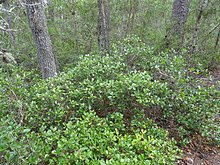Quercus myrtifolia
It is native to the southeastern United States (Mississippi, Alabama, Florida, Georgia, South Carolina).
[4] It is an evergreen tree that can reach 12 meters (39 feet) tall, also appearing as a shrub in drier sites.
Quercus myrtifolia also grows better in shaded and upper dune environments.
It may even be useful for treating tooth aches, gastropathies, burns, and reduce inflammation.
[17] Increased levels of CO2 in the environment of Quercus myrtifolia led to a decrease in leaf area.
[20] It is also possible that mature Myrtle Oaks eventually stop producing acorns making fires important for the growth of new trees.
[20] Quercus myrtifolia displays resiliency to prescribed and lightning caused burns on the Florida Lake Wales Ridge.
[22] After palmetto scrub fires Q. myrtifolia managed to reach preburn values within 5 years.
[9] Burrowing beach mice threaten acorns even when protected by cages.
If growing a Myrtle Oak one should plant in full sun and well drained soil.
[28] If it is planted outside it should be protected from pests, and buried at a depth equal to the diameter of the acorn.
